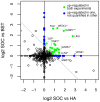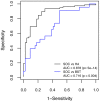Integrative proteomic analysis of serum and peritoneal fluids helps identify proteins that are up-regulated in serum of women with ovarian cancer
- PMID: 20559444
- PMCID: PMC2886122
- DOI: 10.1371/journal.pone.0011137
Integrative proteomic analysis of serum and peritoneal fluids helps identify proteins that are up-regulated in serum of women with ovarian cancer
Abstract
Background: We used intensive modern proteomics approaches to identify predictive proteins in ovary cancer. We identify up-regulated proteins in both serum and peritoneal fluid. To evaluate the overall performance of the approach we track the behavior of 20 validated markers across these experiments.
Methodology: Mass spectrometry based quantitative proteomics following extensive protein fractionation was used to compare serum of women with serous ovarian cancer to healthy women and women with benign ovarian tumors. Quantitation was achieved by isotopically labeling cysteine amino acids. Label-free mass spectrometry was used to compare peritoneal fluid taken from women with serous ovarian cancer and those with benign tumors. All data were integrated and annotated based on whether the proteins have been previously validated using antibody-based assays.
Findings: We selected 54 quantified serum proteins and 358 peritoneal fluid proteins whose case-control differences exceeded a predefined threshold. Seventeen proteins were quantified in both materials and 14 are extracellular. Of 19 validated markers that were identified all were found in cancer peritoneal fluid and a subset of 7 were quantified in serum, with one of these proteins, IGFBP1, newly validated here.
Conclusion: Proteome profiling applied to symptomatic ovarian cancer cases identifies a large number of up-regulated serum proteins, many of which are or have been confirmed by immunoassays. The number of currently known validated markers is highest in peritoneal fluid, but they make up a higher percentage of the proteins observed in both serum and peritoneal fluid, suggesting that the 10 additional markers in this group may be high quality candidates.
Conflict of interest statement
Figures




Similar articles
-
Serum and peritoneal fluid concentrations of soluble human leukocyte antigen, tumor necrosis factor alpha and interleukin 10 in patients with selected ovarian pathologies.J Ovarian Res. 2017 Apr 4;10(1):25. doi: 10.1186/s13048-017-0320-9. J Ovarian Res. 2017. PMID: 28376925 Free PMC article.
-
Proteomic analysis of serum of women with elevated Ca-125 to differentiate malignant from benign ovarian tumors.Asian Pac J Cancer Prev. 2012;13(7):3265-70. doi: 10.7314/apjcp.2012.13.7.3265. Asian Pac J Cancer Prev. 2012. PMID: 22994745
-
The ascites N-glycome of epithelial ovarian cancer patients.J Proteomics. 2017 Mar 22;157:33-39. doi: 10.1016/j.jprot.2017.02.001. Epub 2017 Feb 8. J Proteomics. 2017. PMID: 28188862
-
Microheterogeneity of transthyretin in serum and ascitic fluid of ovarian cancer patients.BMC Cancer. 2005 Oct 17;5:133. doi: 10.1186/1471-2407-5-133. BMC Cancer. 2005. PMID: 16225703 Free PMC article.
-
Inhibin A, B and pro-alphaC in serum and peritoneal fluid in postmenopausal patients with ovarian tumors.Eur J Endocrinol. 2000 Apr;142(4):334-9. doi: 10.1530/eje.0.1420334. Eur J Endocrinol. 2000. PMID: 10754473
Cited by
-
A new method for isolation of interstitial fluid from human solid tumors applied to proteomic analysis of ovarian carcinoma tissue.PLoS One. 2011 Apr 26;6(4):e19217. doi: 10.1371/journal.pone.0019217. PLoS One. 2011. PMID: 21541282 Free PMC article.
-
Identification of multiple novel protein biomarkers shed by human serous ovarian tumors into the blood of immunocompromised mice and verified in patient sera.PLoS One. 2013;8(3):e60129. doi: 10.1371/journal.pone.0060129. Epub 2013 Mar 27. PLoS One. 2013. PMID: 23544127 Free PMC article.
-
Stage-specific analysis of plasma protein profiles in ovarian cancer: Difference in-gel electrophoresis analysis of pooled clinical samples.J Carcinog. 2013 Jun 29;12:10. doi: 10.4103/1477-3163.114216. Print 2013. J Carcinog. 2013. PMID: 23858298 Free PMC article.
-
Proteomic landscape of epithelial ovarian cancer.Nat Commun. 2024 Jul 31;15(1):6462. doi: 10.1038/s41467-024-50786-z. Nat Commun. 2024. PMID: 39085232 Free PMC article.
-
Control values of ovarian cancer tumor markers and standardisation of a protocol for sampling peritoneal fluid and performing washing during laparoscopy.World J Surg Oncol. 2014 Sep 4;12:278. doi: 10.1186/1477-7819-12-278. World J Surg Oncol. 2014. PMID: 25185697 Free PMC article.
References
-
- Etzioni R, Urban N, Ramsey S, McIntosh M, Schwartz S, et al. The case for early detection. Nat Rev Cancer. 2003;3:243–252. - PubMed
-
- Menon U, Skates SJ, Lewis S, Rosenthal AN, Rufford B, et al. Prospective study using the risk of ovarian cancer algorithm to screen for ovarian cancer. J Clin Oncol. 2005;23:7919–7926. - PubMed
-
- Urban N, Drescher C, Etzioni R, Colby C. Use of a stochastic simulation model to identify an efficient protocol for ovarian cancer screening. Control Clin Trials. 1997;18:251–270. - PubMed
-
- Urban N, McIntosh M, Clark L, Jacobs I, Karlan B, et al. Socioeconomics of ovarian cancer screening. Ovarian Cancer 6: Oxford Press; 2002.
Publication types
MeSH terms
Substances
Grants and funding
LinkOut - more resources
Full Text Sources
Other Literature Sources
Medical

